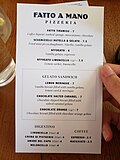Menu
A menu is a list of dishes to be served at a meal. Menus have been around in Europe since the 18th century. There is a special need for them in Chinese cuisine because of the wide range of dishes on offer. Menus have been discovered from the Song Dynasty in China.[1] In the larger cities of the time, the variety of cuisine from different regions led caterers to create a list for their patrons.
In restaurants, the modern menu, with dishes in a set order of courses, was invented by the great French chef Escoffier.[2] Usually there are two types of menu at a good restaurant:[3]
- table d'hôte: a set menu at a fixed price (prix fixée).
- à la carte: a wider choice of items, each with its own price.
Lesser establishments might offer a chalkboard, with the advantage that items can be rubbed out or added on at short notice. Fish restaurants in particular depend on daily catches being supplied or bought in the early morning. They usually list fish freshly bought (as opposed to frozen).
In American restaurant management, "menu engineering" has become a branch of marketing.
Menu Media
Menu showing a list of desserts in a pizzeria
Historical menu card of the banquet for German Emperor Wilhelm II and Empress Auguste Viktoria on September 7, 1898, at the Hotel Kaiserhof, Porta Westfalica
A menu board in a New Orleans diner
References
- ↑ Gernet, Jacques 1962. Daily life in China: on the eve of the Mongol invasion, 1250-1276, pp. 50, 133–134, 137.
- ↑ Spang, Rebecca L. 2000. The invention of the restaurant: Paris and modern gastronomic culture. Harvard University Press. ISBN 0-674-00685-2
- ↑ Rambourg, Patrick 2013. À table... le menu! Paris: Honoré Champion. ISBN 978-2745325808








